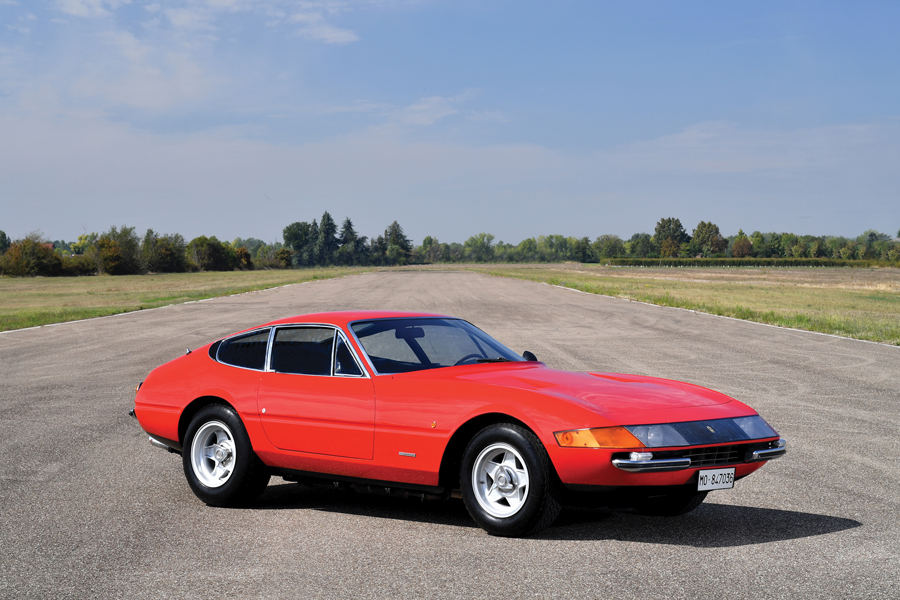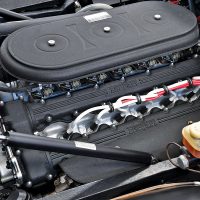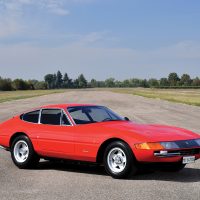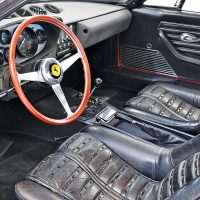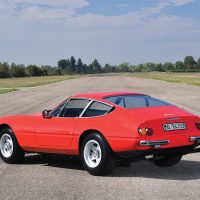Representing a paradigm shift in Ferrari’s design language, the 365 GTB/4 Berlinetta, later nicknamed the “Daytona,” was first introduced to the world at the 1968 Paris Motor Show.
An early European-specification example with Plexiglas headlight covers, this Daytona was originally finished in Blu Dino over a Nero interior. Completed by the factory in September of 1969, it was immediately shipped to Maranello Concessionaires in England. It is believed that when new, this car was likely used personally by Colonel Ronnie Hoare of Maranello Concessionaires before being sold new to its first private owner. The Daytona then passed through another British owner and was repainted gray with a black stripe.
Later, refinished in red, it returned to its native Italy, where its most recent owner acquired it in 2006.
Confirmed as a matching-numbers example, this would be a wonderful Daytona to drive and enjoy as an example of one of Ferrari’s most celebrated road cars. Chassis number 12905 is indeed a highlight of the Duemila Ruote collection and would continue to hold pride of place at any Ferrari gathering.
SCM Analysis
Detailing
| Vehicle: | 1969 Ferrari 365 GTB/4 Daytona Berlinetta “Plexi” |
| Years Produced: | 1968–73 |
| Number Produced: | 1,279 coupes |
| Original List Price: | $19,500 |
| SCM Valuation: | $772,800 |
| Tune Up Cost: | $3,500 |
| Distributor Caps: | $195 for a reproduction; $450 for original factory equipment |
| Chassis Number Location: | On frame above right front spring mount |
| Engine Number Location: | Below head on rear passenger’s side of block |
| Club Info: | Ferrari Club of America |
| Website: | http://www.FerrariClubofAmerica.org |
| Alternatives: | 1971–72 Maserati Ghibli SS, 1969–70 Aston Martin DB6, 1971–72 Lamborghini Miura SV, 1973 Porsche Carrera RS |
| Investment Grade: | B |
This car, Lot 876, sold for $925,317, including buyer’s premium, at RM Sotheby’s Duemila Ruote sale on November 27, 2016.
If you think a real Ferrari has to have two seats and a front-mounted, carbureted V12 engine, you’re in luck with a Daytona.
The Ferrari 365 GTB/4 Daytona embodies everything great Ferraris are known for. It has a front engine, it is fast, and Pininfarina designed the body with a classic Ferrari silhouette.
Topping the cake, it has a proud racing heritage. The Daytona’s 352-hp, 4.4-liter 12-cylinder engine is highlighted with a row of six 2-barrel Weber carburetors and shows off some of the most perfect alloy casting to ever come out of Italy.
Driving a Daytona is a sensual experience of sight, smell and touch.
The aural delights originate up front, where a purposeful-sounding starter motor turns the engine, igniting whirling chains, spinning gears, and the whoosh of air being gulped through huge carburetors. The mechanical pandemonium is slightly muted when a tap of the throttle sends thunder through the exhaust. No fuel-injected, rubber-timing-belt engine comes close to producing the sound of a Daytona.
Gasoline and leather provide fragrance for the car. Despite devices designed to capture any fuel fumes, a little evaporated fuel escapes the carburetors. A light hint of gas slightly lingers in the trunk, which is the home of the gas tanks. When mixed with the smell of Connolly leather, the light petroleum overtone enhances the Daytona experience.
Daytonas were designed to drive rock steady at 180 mph, so the controls feel a little heavy at lower speeds. The steering is famously stiff, the brakes need a good push, and the shifter takes some effort to move. If you want easy, buy a Mercedes. If you want a drive you’ll remember weeks after your journey, a Daytona fits the bill.
Visually, the Daytona silhouette starts with an impossibly long hood and ends with a graceful fastback rear end. There are curves everywhere.
The seats are serious buckets that are so stylish that variations of them are still offered on most new Ferraris. The dash, the wheels and the bumpers are timeless Ferrari icons.
Money moving into the market
There has been a slide in many collector car values, and Daytonas have not been immune to the trend. They have, however, proven to be resilient, and this is probably a good time to buy one.
Despite any negative reports on the economy, the number of people with big money keeps going up. In 1987, Forbes estimated there were 140 billionaires on the planet. Today they estimate the number is 1,810. In 1980, $125,000 a year put you in the top 1% of U.S. households. Today that number is over $450,000. Over 10.4 million U.S. households have a $1,000,000-plus net worth.
That’s a lot of wealth and it will continue to grow. A percentage of that money will get spent on classic cars, and that pool is also getting bigger.
Money chases the best cars — or at least what they believe to be the best cars. If your lust is focused on a TR6, you’re pretty safe. But if you’re chasing a major classic, you’ll need to work harder in the future.
A-grade collectible cars will continue to be collected with more and more money chasing them. Wealthy collectors will always lust for a 300SL Mercedes, a 507 BMW and great Ferraris.
Trends are fickle, and investing in a trendy car is more of a gamble. Paying a premium for a fiberglass 308 or rare 6-speed version of a modern model is sensible, but when just the premium exceeds the value of the standard model, you’re buying bragging rights — not a sound investment.
Daytonas aren’t quite A-grade collectibles, but they aren’t far off.
They tick all the boxes for a great car, but there are a few too many of them to push them over a B grade. While a Daytona is not a cornerstone of a Ferrari collection, a Daytona is a pillar that every significant collection should have.
I can’t imagine a scenario where Daytonas don’t continue to appreciate.
An interesting car — and an interesting sale
RM Sotheby’s Daytona chassis 12905 is an interesting car.
It is probably the first Daytona that was sent to the U.K., and the U.K. Ferrari distributor probably evaluated the car before RHD U.K. models were built.
It has a wood steering wheel — as normally found on early Daytonas. The fixed headlights have Plexiglas covers rather than the pop-up headlights found on later cars, and what appear to be wide rear wheels.
The car looks to be in very good cosmetic condition, and the leather has a bit of patina.
If you don’t know the details of the Duemila Ruote auction, you really should look them up. The sheer size and circumstances of the sale are fascinating. The details are well covered in this month’s “Legal Files” column on p. 52.
The basic story is this: A man skims other people’s money to build a huge collection of toys. The Italian government catches him and takes his toys away. The auction of the toys nearly doubles estimates.
Exuberance and inexperience
The Duemila Ruote auction was a feeding frenzy of new buyers who paid way too much for incredibly interesting — but mostly marginal — cars. When the sale was over, an astonishing number of buyers were buried so deep in their new purchases that they will never see the light of day.
Our subject Daytona was the fourth-highest sale of the weekend, and like most of the cars at the sale, it sold for an unrealistically high number.
Unlike many of the other cars, the Daytona was in very presentable condition. An argument can be made that the bidders were paying a premium for the Plexi nose and the U.K. history. I think the high price was a clear case of auction fever.
The buyer got a good car that he or she will hopefully enjoy. It will take a while for the market to catch up, but the chances are good that it will get there. ♦
(Introductory description courtesy of RM Sotheby’s.)
